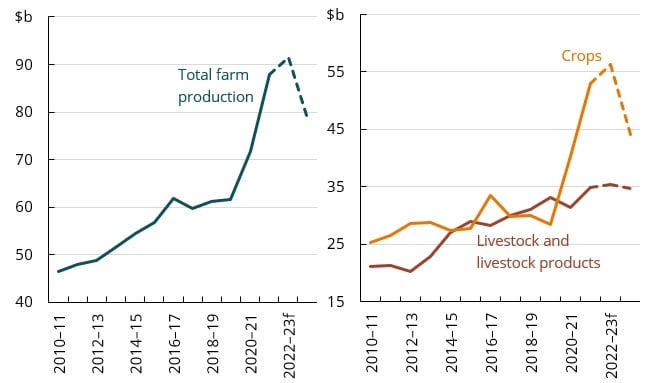 Following three record-breaking years in the agriculture sector, value of production is expected to contract in 2023-24 on the back of forecast drier conditions.
Following three record-breaking years in the agriculture sector, value of production is expected to contract in 2023-24 on the back of forecast drier conditions.
In its June agricultural outlook, the Australian Bureau of Agricultural and Resource Economics and Sciences has forecast the overall value of the agriculture sector will contract by 14 per cent, down from the anticipated $90 billion this financial year.
ABARES executive director Dr Jared Greenville said the reduction was to be expected after the records broken in the past three years.
“The value of agricultural production will still reach $79 billion in 2023-24, which is an expected fall given the circumstances,” Dr Greenville said.
“We are expecting exports to follow suit, falling by 17pc to $65 billion in 2023-24, which would be the third-highest result on record.”
The outlook has been revised down from what ABARES released in their Agricultural Commodities Report in March, when it was forecast the production value would be $81 billion.
The biggest driver of the decrease is drier climatic conditions brought on by the expectation of an El Niño and/or a positive Indian Ocean Dipole, which will reduce crop yields.
 Above: Gross value of farm production to fall from record highs. Source: ABS; ABARES.
Above: Gross value of farm production to fall from record highs. Source: ABS; ABARES.
A fall in domestic prices received by producers for most commodities is also on the cards, as global prices ease from recent highs.
“Crop production in 2023-24 is forecast to fall by 34pc from record production volume in 2022-23. At the same time, domestic prices for most crops are expected to fall in 2023-24,” Dr Greenville said.
“The results are more mixed for the livestock sector. There will be slight increases in production across beef, sheep and milk, but a drop in the value of livestock production to $35 billion in 2023-24 because of lower prices.
“This is down to a number of factors, such as less demand for restocking, and like crops, we expect global production to pick up.
“We are also expecting a strong 2023-24 for the wool market. Strong demand for Australian wool from China is forecast to increase wool prices, with production values expected to rise by $175 million in 2023-24.”
Although a notable decrease in the value of agricultural production is forecast for next financial year, overall, it is still likely to be the third highest on record (fourth in real terms).
El Niño alert now in play
The ABARES outlook came on the same day as an El Niño alert was issued by the Bureau of Meteorology.
Moving from a watch to an alert means there is around a 70pc chance of an El Niño developing this year, equating to roughly three times the normal chance of an El Niño forming.
BoM senior climatologist Catherine Ganter said climate models and indicators now meet the Bureau's El Niño alert criteria.
"While the models show it's very likely the tropical Pacific Ocean temperatures will reach El Niño levels during winter, we have seen some movement in the atmosphere towards El Niño conditions," Ms Ganter said.
"While our El Niño alert criteria have been met, these changes will need to strengthen and sustain themselves over a longer period for us to consider an El Niño event."
An El Niño would mean a higher chance of drier weather in eastern Australia and an increased likelihood of it being warmer than usual for the southern two-thirds of Australia.
"The Bureau's long-range winter forecast is for drier and warmer conditions across almost all of Australia and the climate conditions in the Pacific Ocean are already factored into our forecasts," Ms Ganter said.
"The long-range forecast for winter also shows an increased chance of below average rainfall for almost all of Australia and the move to El Niño alert does not change this forecast.”
To what extent the country will be affected by an El Niño remains unclear though, with CSIRO senior research scientist Dr Nandini Ramesh saying it's still difficult at this point to say with confidence whether it will be a high-magnitude event.
"International forecasts suggest a moderate-strength El Niño event is the most likely outcome, followed by a high-strength El Niño event," Dr Ramesh said.
"The uncertainty about this comes from the atmosphere, which has had a relatively muted response thus far to the now well-established warm sea surface temperatures.
"How strong the El Niño event gets now depends on how the atmosphere evolves over the next few months."
 Results
Results
